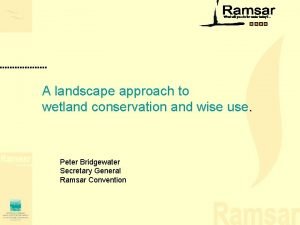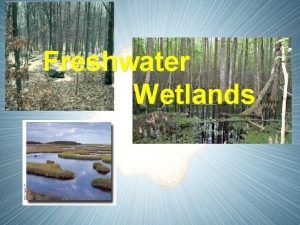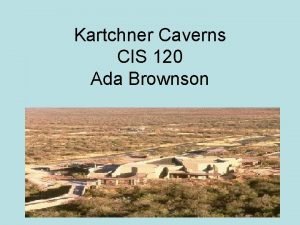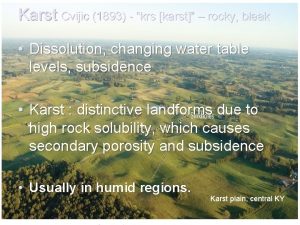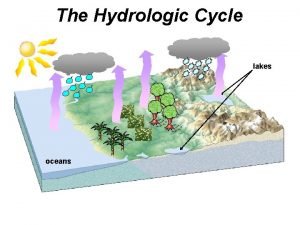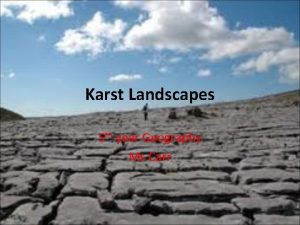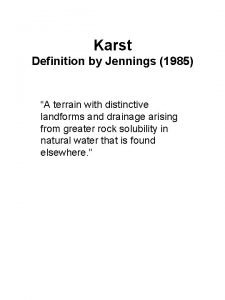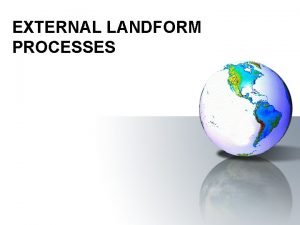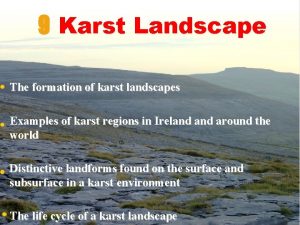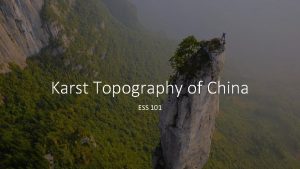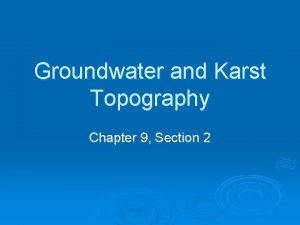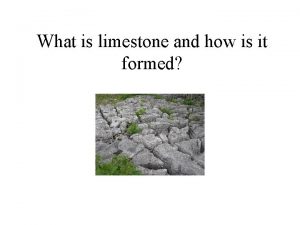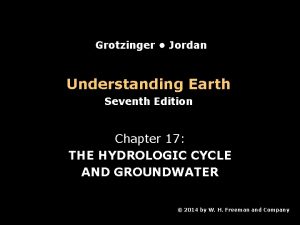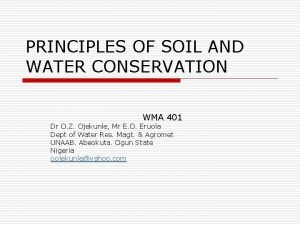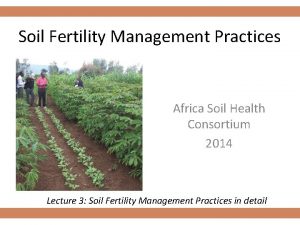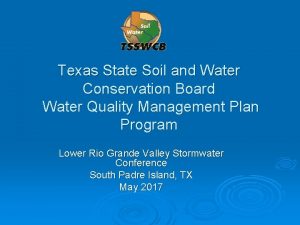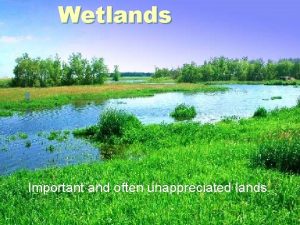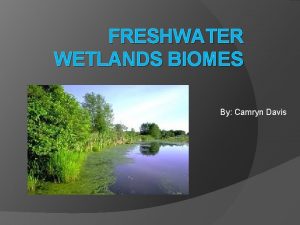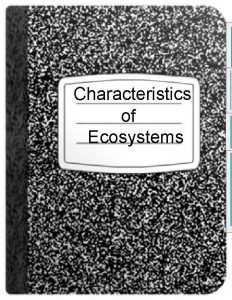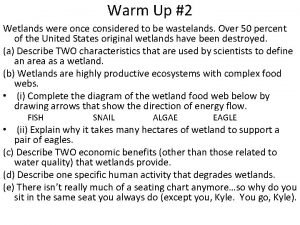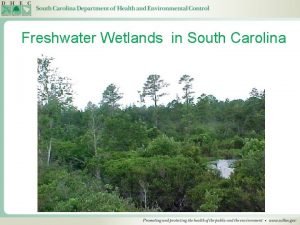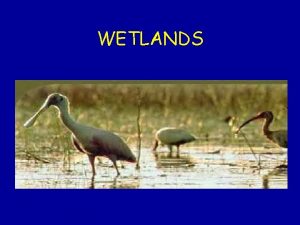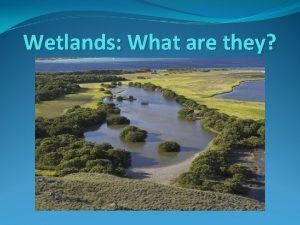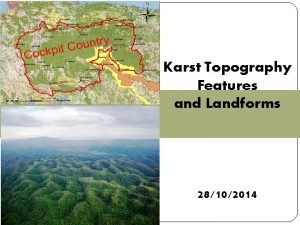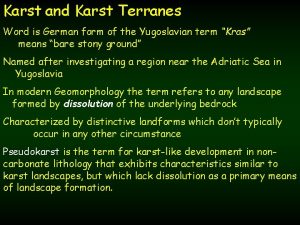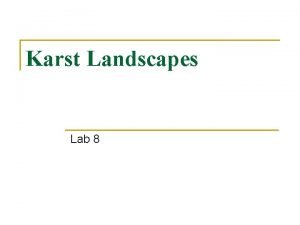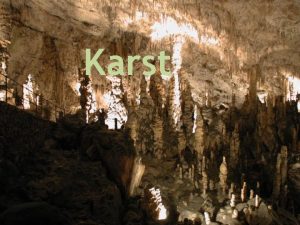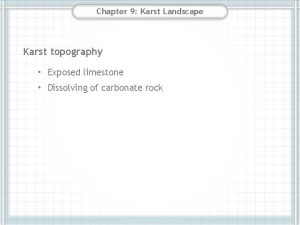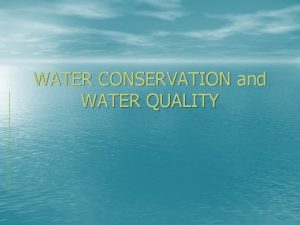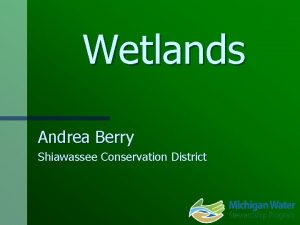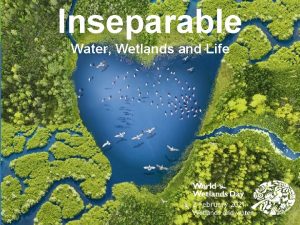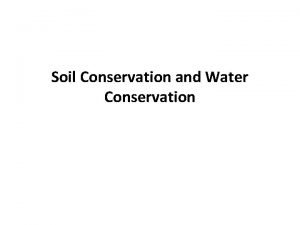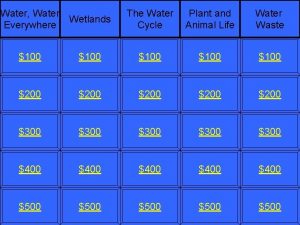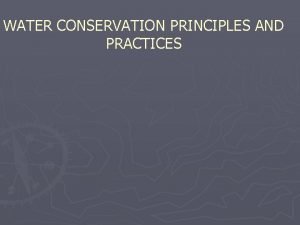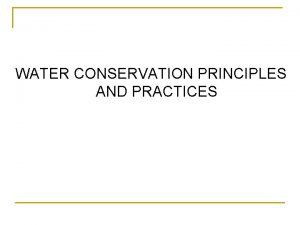CONSERVATION OF WATER AND WETLANDS Karst Wetlands of






















- Slides: 22

CONSERVATION OF WATER AND WETLANDS Karst Wetlands of International Importance Sarah Young Aust Govt Dept of the Environment and Heritage (on behalf of the Ramsar Convention Secretariat)

What is the Convention on Wetlands? • Oldest of the global environmental conventions • Only global convention focussing on an ecosystem (wetlands) • Covers wide range of wetlands types - from coral reefs to mountains Why the “Ramsar” Convention? • Ramsar, Iran - where Convention agreed on 2 February 1971 by 18 countries (incl Australia) • Celebrated annually on World Wetlands Day - 2 February – WWD 2003: No Wetlands-No Water! – WWD 2004: From the Mountains to the Sea – WWD 2005: Cultural and biological diversity of wetlands

Ramsar’s definition of “wetland” “wetlands areas of marsh, fen, peatland or water, whether natural or artificial, permanent or temporary, with water that is static or flowing, fresh, brackish or salt, including areas of marine water the depth of which at low tide does not exceed six metres” (Article 1. 1)

Ramsar covers • Natural and human-made wetlands • Inland/freshwater: – marshes, rivers, lakes, reservoirs etc. • Coastal/marine – lagoons, estuaries, mangroves, coral reefs, seagrass beds etc. • Above ground and underground – karst and caves • BUT not deep oceans

Ramsar’s Mission “The conservation and wise use of wetlands through local, regional and national actions and international cooperation as a contribution towards achieving sustainable development throughout the world. ” (Strategic Plan 2003 -2008)

Ramsar Achievements • global membership - 141 Contracting Parties • 1387 Ramsar sites covering 122. 7 million ha – largest ‘protected area’ network in world • broad recognition of wetlands • policy and technical guidelines • synergies with other MEAs • increasing resources and capacity to countries

Ramsar Contracting Parties commit to delivering the Convention through 3 “pillars” (Strategic Plan, 2003 -2008): • Wise use of all wetlands • Wetlands of International Importance - designation and management • International cooperation

What is the “wise use” of wetlands? “… their sustainable utilization for the benefit of humankind in a way compatible with the maintenance of the natural properties of the ecosystem” (Ramsar COP 3, 1987; Article 3. 1 of the Convention)

”Wise use” applies to all wetlands • Policy formulation and implementation: – International/regional cooperation – Sectoral cooperation – National wetland policies (incl. raising awareness) • River basin management • Site designation and management – Involvement of local people and other stakeholders

Ramsar Sites • Ramsar sites are designated "To develop and maintain an international network of wetlands which are important for the conservation of global biological diversity and for sustaining human life through the ecological and hydrological functions they perform. ” • Criteria for site selection – A wetland that is a representative, rare or unique wetland type – A wetland that is particularly important for conserving biological diversity • Guidelines for site management – working with local people and other stakeholders

Parties commit to: • preventing any loss or damage to the sites (maintaining ecological character) • developing a management planning process, stressing the importance of – full local community and other stakeholder involvement from the earliest stages – ensuring that wetland sites are managed in the broader context of basin scale and coastal zone management, and of impact assessment, risk assessment, monitoring and restoration

Wetlands and karst systems The common key features • depend on water and hydrological system of the catchment area • require water quantity and quality to maintain: – the form and structure of karst – the ecological character of a wetland • fragile systems • lack of knowledge and understanding – characteristics – processes of formation and maintenance of values

Wetlands and karst systems Ramsar recognition Brisbane 1996 (Co. P 6) • Subterranean karst and cave hydrological systems recognised as a wetland type • Countries urged to designate karst sites San Jose 1999 (Co. P 7) • Guidelines for identifying and designating karst and other subterranean hydrological systems • Countries urged to give greater consideration to conservation of karst wetlands

Wetland Conservation Values Principle values (as per Article 2. 2): · uniqueness of karst phenomena/functions and functioning; · inter-dependency and fragility of karst systems and their hydrological and hydrogeological characteristics; · uniqueness of these ecosystems and endemism of their species; · importance for conserving particular taxa of fauna and flora.

Wetland Conservation Values Cultural and socio-economic values · · Supply of drinking water Water for grazing or agriculture Tourism Recreation

Subterranean Ramsar sites Main goal is: to assist the conservation and wise use of subterranean wetland functions and values and thus implementation of Ramsar principles and strategic guidelines. AND, most characteristic karst wetlands are considered and added to the Ramsar List.

Surface or subterranean wetlands • Many "living" karst areas are wetlands • Development pressures are increasing – direct: visitors to caves, researchers – indirect: including pollution, particularly water pollution, dumping of solid waste, sewage, development of infrastructure, etc.

Action needed • Appropriate management (conservation and sustainable use) to maintain functions and values of interacting karst surface and subterranean hydrological systems in whole catchment area and to prevent or mitigate threats to karst wetlands • Only 26 karst/subterranean wetlands Ramsar sites globally (<2% of 1387 Ramsar sites) – additional sites to be listed

Karst wetlands in Australia Current state of play • potentially 1000’s of sites occur right across Australia, however no systematic assessment of wetland values • 1 Ramsar site – “The Dales”, Christmas Island • 9 sites in A Directory of Important Wetlands in Australia – 2 in Qld (Spring Tower Complex, Undara Lava Tubes*) – 2 in SA (Ewens Ponds, Piccaninnie Ponds) – 5 in WA (Cape Range Subterranean Waterways*, Bundera Sinkhole*, Lake Mac. Leod, Tunnel Creek*, Loch Mc. Ness System) * these wetlands listed solely as karst sites

Internationally and nationally important karst wetlands in Australia

Karst wetlands in Australia The future • Australian Govt considering Ramsar listing Bundera Sinkhole, WA (WA Govt considering broader Cape Range area) • SA Govt considering Ramsar listing Piccaninnie Ponds • Raise awareness of values and functions of karst/subterranean wetlands • Celebrate World Wetlands Day/Week (2 -9 Feb 2005) at your local karst/subterranean wetland

Thank you!
 Conservation of wetlands
Conservation of wetlands Water and water and water water
Water and water and water water An ecosystem in which water either covers the soil
An ecosystem in which water either covers the soil Caves and karst webquest
Caves and karst webquest Karst topography diagram
Karst topography diagram Karst topography
Karst topography Karst definition geography
Karst definition geography Karst types
Karst types Blind valley
Blind valley Karst topography
Karst topography Karst landscape examples ireland
Karst landscape examples ireland China karst topography
China karst topography Karst
Karst Disappearing streams karst topography
Disappearing streams karst topography Clint and grykes
Clint and grykes Understanding earth 7th edition
Understanding earth 7th edition Objectives of water conservation
Objectives of water conservation Agronomic measures of soil and water conservation
Agronomic measures of soil and water conservation Texas state soil and water conservation board
Texas state soil and water conservation board Why are wetlands important
Why are wetlands important Climate of freshwater wetlands
Climate of freshwater wetlands Bill nye rivers and streams
Bill nye rivers and streams Wetlands were once considered to be wastelands
Wetlands were once considered to be wastelands
